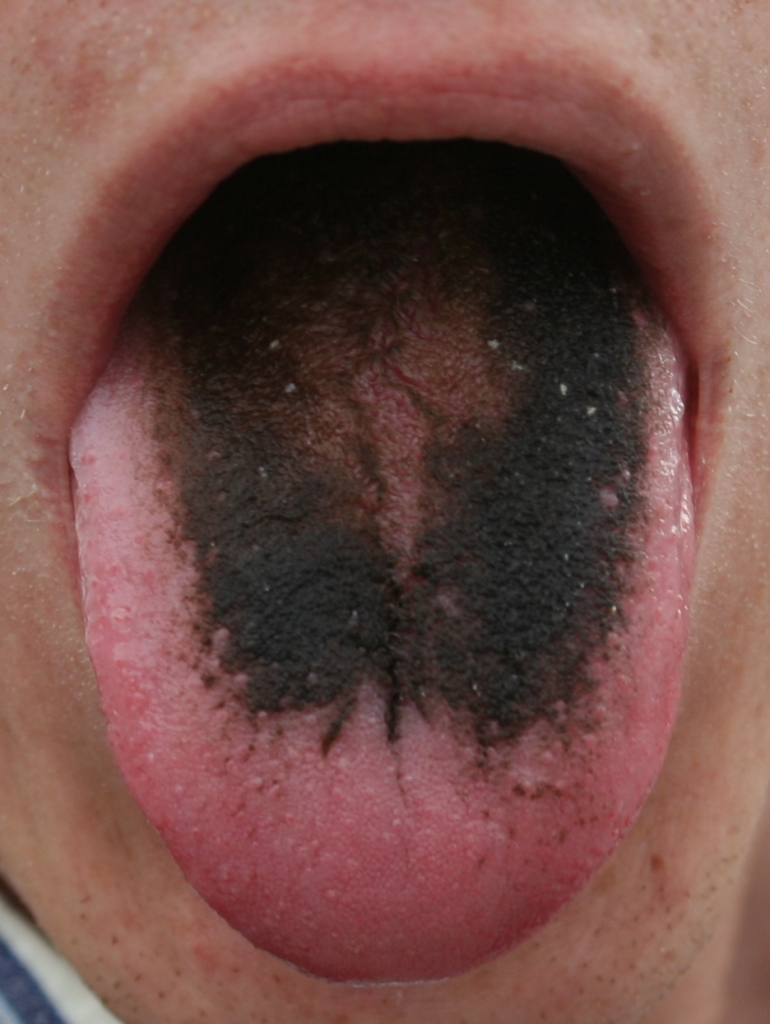Black hairy tongue
| Black hairy tongue | |
 | |
|---|---|
| A picture of Black hairy tongue | |
| ICD-10 | K14.3 |
| ICD-9 | 529.3 |
| DiseasesDB | 31923 |
| eMedicine | derm/639 |
Please Take Over This Page and Apply to be Editor-In-Chief for this topic: There can be one or more than one Editor-In-Chief. You may also apply to be an Associate Editor-In-Chief of one of the subtopics below. Please mail us [1] to indicate your interest in serving either as an Editor-In-Chief of the entire topic or as an Associate Editor-In-Chief for a subtopic. Please be sure to attach your CV and or biographical sketch.
Black hairy tongue refers to a number of conditions of humans and animals that cause the tongue to become unusually dark and/or hairy in appearance.
Black hairy tongue in humans is a harmless condition caused by a fungus which grows on the top surface of the tongue.[1] It is associated with the elderly, as well as with antibiotic use. It is more commonly seen in tobacco smokers. While black is the most common color associated with the condition other colors are also possible.
Causes in Humans
Hairy tongue (lingua villosa) is a common condition caused by defective desquamation of the filiform papillae that results from a variety of precipitating factors. Some of these factors include poor oral hygiene, tooth loss (because their soft diet does not allow for normal desquamation from rough food scraping the tongue), chronic or extensive use of antibiotics, and radiation treatments to the head and neck. Patients with hairy tongue are more often than not coffee or tea drinkers and often use tobacco. It is also commonly seen in patients who are HIV positive or use intravenous drugs, although there is no predictive value to the finding of hairy tongue. One would assume that it is the result of shared lifestyle habits such as poor oral hygiene, use of tobacco/marijuana, coffee drinking, etc.
Hairy tongue is often referred to as black hairy tongue (lingua villosa nigra), but it may also appear brown, white, green, or pink - often due to secondary factors such as mouthwashes, breath mints etc. The "hairy" areas are usually on the posterior (back) of the tongue and never involve the undersurface. Hairy tongue is not a harmful disorder, and is normally asymptomatic. Patients with hairy tongue often may develop a secondary infection of Candida albicans (thrush). It is unclear if hairy tongue itself is a predisposing factor, as the underlying causes of hairy tongue may also lead to the development of thrush.
Pepto-Bismol has been known to cause one's tongue and stool to turn black.[2] This form of "black tongue", however, is a result of the separation of bismuth from salicylate, forming bismuth trisulfide (Bi2S3) in combination with the sulfur found in saliva.[3]
Treatment
Treatment consists of good oral hygiene and use of a toothbrush or tongue scraper to aid with the desquamation of the tongue. Use of antifungals may be warranted if there is a suspicion of candidal infection.
If antibiotic use lead to the condition then the condition may resolve naturally after the antibiotic course is completed.
In Animals
Black tongue is a condition seen in dogs, caused by a deficiency of niacin, associated with ulcers and inflammation of the dog's oral cavity.
See also
External Links
References
Template:SIB
Template:Oral pathology
de:Haarzunge
hu:Szőrös nyelv